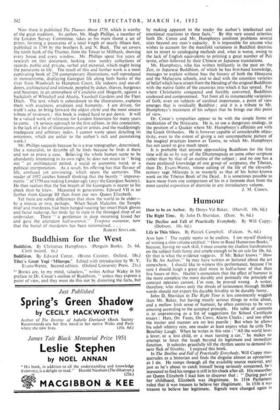Buddhism for the West
" Boom are, to my mind, valueless," writes Arthur Waley in his preface to Dr. Conze's outline of Buddhism, " unless they express a point of view, and they must do this not by distorting the facts, but by making apparent to the reader the author's intellectual and emotional reactions to these facts." By this very sound criterion both Dr. Conze and Mr. Humphreys confront problems several sizes beyond any man's capacity. It is impossible for anyone who wishes to account for the manifold variations in Buddhist doctrine not to resort to cataloguing methods and, what is worse, owing to the lack of English equivalents to printing a great number of Pali terms, often followed by their Chinese or Japanese translations.
Mr. Humphreys, who has written brilliantly in the past on the Zen, or Japanese Buddhism, of which he has first-hand knowledge, manages to explain without bias the history of both the Hinayana and the Mahayana schools; and to deal with the countless varieties of belief which have arisen from the blending of the original Buddhism with the native faiths of the countries into which it has spread. For where Christianity conquered and forcibly converted, Buddhism coalesced and compromised. Yet from all its innumerable variations of faith, even on subjects of cardinal importance, a point of view emerges that is residually Buddhist ; and it is a tribute to Mr. Humphreys's treatment of his subject that he brings out this point of view.
Dr. Conze's sympathies appear to be with the simple forms of meditation of the Hinayana. He is, to use a dangerous analogy, in the position of a Quaker where Mr. Humphreys's affinities are with the Greek Orthodox. He is however capable of considerable objec- tivity, even to the extent of giving a not unsympathetic picture of the magical practices known as Tantra, to which Mr. Humphreys has not cared to give much space.
It is probable that anyone approaching Buddhism for the first time will do so by way of the Dhammapada or some other scripture rather than by that of an outline of the subject ; and no one has a more profound knowledge of one group of scriptures, the Tibetan, than Dr. Evans-Wentz, whose editing of the life of the eleventh- century sage Milarepa is as masterly as that of his better-known work on the Tibetan Book of the Dead. It is sometimes possible to learn more from one comparison of his in a footnote than from the most careful exposition of doctrine in any introductory volume.
J. M. COHEN.










































 Previous page
Previous page